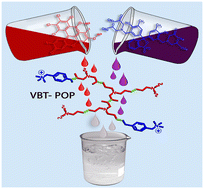A cationic porous polymer as a robust and recyclable adsorbent for the removal of harmful dyes from aqueous contaminants†
Abstract
Adsorptive removal of organic dyes is considered as one of the most advanced technologies for water purification. Herein, a new nitrogen rich cationic porous organic polymer (VBT-POP) has been synthesized through the aqueous phase radical polymerization of triallylamine and (p-vinylbenzyl)trimethylammonium chloride. VBT-POP has been thoroughly characterized and used for the selective and quantitative adsorptive removal of two anionic dyes rose bengal (RB) and xylenol orange (XO) under different conditions. The VBT-POP is chemically and thermally robust in nature with a positive zeta potential. VBT-POP follows pseudo-second order adsorption kinetics for these two dyes. It follows the Langmuir adsorption isotherm with exceptionally high dye uptake capacities of 1252 mg g−1 for RB and 735 mg g−1 for XO. Sorption properties are compared considering the effects of pH and temperature. Calculation of various thermodynamic parameters reveals endothermic spontaneous adsorption along with wide pH range applicability. A proposed electrostatic interaction model of the adsorption mechanism has also been explored. Alkaline NaCl solutions almost completely desorb the adsorbed dyes through ultrasound treatment (UT). VBT-POP exhibited very good recyclability and high stability for the removal of these dyes from contaminated aqueous solutions for several consecutive adsorption cycles.

- This article is part of the themed collection: Nanomaterial applications in water


 Please wait while we load your content...
Please wait while we load your content...